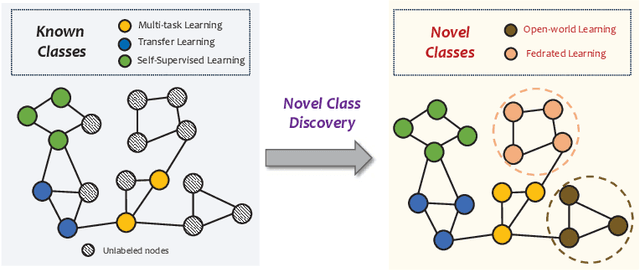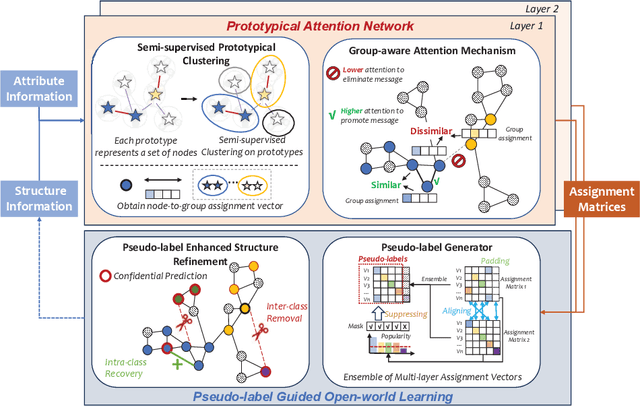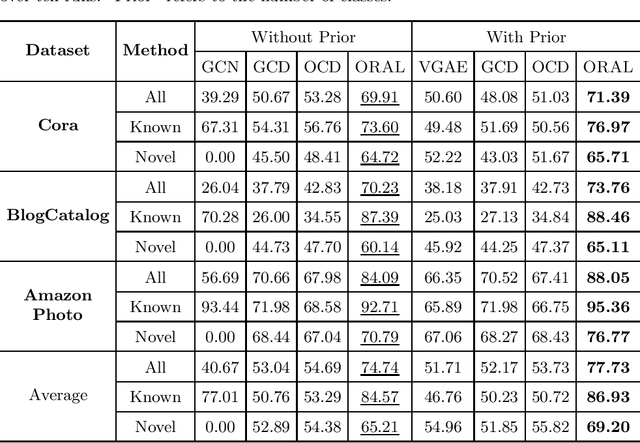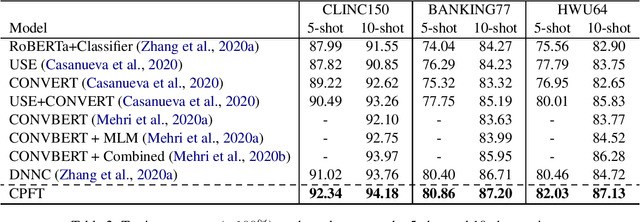Philip Yu
Automating Personalization: Prompt Optimization for Recommendation Reranking
Apr 04, 2025Abstract:Modern recommender systems increasingly leverage large language models (LLMs) for reranking to improve personalization. However, existing approaches face two key limitations: (1) heavy reliance on manually crafted prompts that are difficult to scale, and (2) inadequate handling of unstructured item metadata that complicates preference inference. We present AGP (Auto-Guided Prompt Refinement), a novel framework that automatically optimizes user profile generation prompts for personalized reranking. AGP introduces two key innovations: (1) position-aware feedback mechanisms for precise ranking correction, and (2) batched training with aggregated feedback to enhance generalization.
RiemannGFM: Learning a Graph Foundation Model from Riemannian Geometry
Feb 05, 2025



Abstract:The foundation model has heralded a new era in artificial intelligence, pretraining a single model to offer cross-domain transferability on different datasets. Graph neural networks excel at learning graph data, the omnipresent non-Euclidean structure, but often lack the generalization capacity. Hence, graph foundation model is drawing increasing attention, and recent efforts have been made to leverage Large Language Models. On the one hand, existing studies primarily focus on text-attributed graphs, while a wider range of real graphs do not contain fruitful textual attributes. On the other hand, the sequential graph description tailored for the Large Language Model neglects the structural complexity, which is a predominant characteristic of the graph. Such limitations motivate an important question: Can we go beyond Large Language Models, and pretrain a universal model to learn the structural knowledge for any graph? The answer in the language or vision domain is a shared vocabulary. We observe the fact that there also exist shared substructures underlying graph domain, and thereby open a new opportunity of graph foundation model with structural vocabulary. The key innovation is the discovery of a simple yet effective structural vocabulary of trees and cycles, and we explore its inherent connection to Riemannian geometry. Herein, we present a universal pretraining model, RiemannGFM. Concretely, we first construct a novel product bundle to incorporate the diverse geometries of the vocabulary. Then, on this constructed space, we stack Riemannian layers where the structural vocabulary, regardless of specific graph, is learned in Riemannian manifold offering cross-domain transferability. Extensive experiments show the effectiveness of RiemannGFM on a diversity of real graphs.
Uncertainty Quantification on Graph Learning: A Survey
Apr 23, 2024


Abstract:Graphical models, including Graph Neural Networks (GNNs) and Probabilistic Graphical Models (PGMs), have demonstrated their exceptional capabilities across numerous fields. These models necessitate effective uncertainty quantification to ensure reliable decision-making amid the challenges posed by model training discrepancies and unpredictable testing scenarios. This survey examines recent works that address uncertainty quantification within the model architectures, training, and inference of GNNs and PGMs. We aim to provide an overview of the current landscape of uncertainty in graphical models by organizing the recent methods into uncertainty representation and handling. By summarizing state-of-the-art methods, this survey seeks to deepen the understanding of uncertainty quantification in graphical models, thereby increasing their effectiveness and safety in critical applications.
Beyond the Known: Novel Class Discovery for Open-world Graph Learning
Mar 29, 2024



Abstract:Node classification on graphs is of great importance in many applications. Due to the limited labeling capability and evolution in real-world open scenarios, novel classes can emerge on unlabeled testing nodes. However, little attention has been paid to novel class discovery on graphs. Discovering novel classes is challenging as novel and known class nodes are correlated by edges, which makes their representations indistinguishable when applying message passing GNNs. Furthermore, the novel classes lack labeling information to guide the learning process. In this paper, we propose a novel method Open-world gRAph neuraL network (ORAL) to tackle these challenges. ORAL first detects correlations between classes through semi-supervised prototypical learning. Inter-class correlations are subsequently eliminated by the prototypical attention network, leading to distinctive representations for different classes. Furthermore, to fully explore multi-scale graph features for alleviating label deficiencies, ORAL generates pseudo-labels by aligning and ensembling label estimations from multiple stacked prototypical attention networks. Extensive experiments on several benchmark datasets show the effectiveness of our proposed method.
Motif-aware Riemannian Graph Neural Network with Generative-Contrastive Learning
Jan 02, 2024Abstract:Graphs are typical non-Euclidean data of complex structures. In recent years, Riemannian graph representation learning has emerged as an exciting alternative to Euclidean ones. However, Riemannian methods are still in an early stage: most of them present a single curvature (radius) regardless of structural complexity, suffer from numerical instability due to the exponential/logarithmic map, and lack the ability to capture motif regularity. In light of the issues above, we propose the problem of \emph{Motif-aware Riemannian Graph Representation Learning}, seeking a numerically stable encoder to capture motif regularity in a diverse-curvature manifold without labels. To this end, we present a novel Motif-aware Riemannian model with Generative-Contrastive learning (MotifRGC), which conducts a minmax game in Riemannian manifold in a self-supervised manner. First, we propose a new type of Riemannian GCN (D-GCN), in which we construct a diverse-curvature manifold by a product layer with the diversified factor, and replace the exponential/logarithmic map by a stable kernel layer. Second, we introduce a motif-aware Riemannian generative-contrastive learning to capture motif regularity in the constructed manifold and learn motif-aware node representation without external labels. Empirical results show the superiority of MofitRGC.
Mitigating Health Disparity on Biased Electronic Health Records via Deconfounder
Aug 22, 2023Abstract:The fairness issue of clinical data modeling, especially on Electronic Health Records (EHRs), is of utmost importance due to EHR's complex latent structure and potential selection bias. It is frequently necessary to mitigate health disparity while keeping the model's overall accuracy in practice. However, traditional methods often encounter the trade-off between accuracy and fairness, as they fail to capture the underlying factors beyond observed data. To tackle this challenge, we propose a novel model called Fair Longitudinal Medical Deconfounder (FLMD) that aims to achieve both fairness and accuracy in longitudinal Electronic Health Records (EHR) modeling. Drawing inspiration from the deconfounder theory, FLMD employs a two-stage training process. In the first stage, FLMD captures unobserved confounders for each encounter, which effectively represents underlying medical factors beyond observed EHR, such as patient genotypes and lifestyle habits. This unobserved confounder is crucial for addressing the accuracy/fairness dilemma. In the second stage, FLMD combines the learned latent representation with other relevant features to make predictions. By incorporating appropriate fairness criteria, such as counterfactual fairness, FLMD ensures that it maintains high prediction accuracy while simultaneously minimizing health disparities. We conducted comprehensive experiments on two real-world EHR datasets to demonstrate the effectiveness of FLMD. Apart from the comparison of baseline methods and FLMD variants in terms of fairness and accuracy, we assessed the performance of all models on disturbed/imbalanced and synthetic datasets to showcase the superiority of FLMD across different settings and provide valuable insights into its capabilities.
Mitigating Frequency Bias in Next-Basket Recommendation via Deconfounders
Nov 16, 2022



Abstract:Recent studies on Next-basket Recommendation (NBR) have achieved much progress by leveraging Personalized Item Frequency (PIF) as one of the main features, which measures the frequency of the user's interactions with the item. However, taking the PIF as an explicit feature incurs bias towards frequent items. Items that a user purchases frequently are assigned higher weights in the PIF-based recommender system and appear more frequently in the personalized recommendation list. As a result, the system will lose the fairness and balance between items that the user frequently purchases and items that the user never purchases. We refer to this systematic bias on personalized recommendation lists as frequency bias, which narrows users' browsing scope and reduces the system utility. We adopt causal inference theory to address this issue. Considering the influence of historical purchases on users' future interests, the user and item representations can be viewed as unobserved confounders in the causal diagram. In this paper, we propose a deconfounder model named FENDER (Frequency-aware Deconfounder for Next-basket Recommendation) to mitigate the frequency bias. With the deconfounder theory and the causal diagram we propose, FENDER decomposes PIF with a neural tensor layer to obtain substitute confounders for users and items. Then, FENDER performs unbiased recommendations considering the effect of these substitute confounders. Experimental results demonstrate that FENDER has derived diverse and fair results compared to ten baseline models on three datasets while achieving competitive performance. Further experiments illustrate how FENDER balances users' historical purchases and potential interests.
Continuous Prompt Tuning Based Textual Entailment Model for E-commerce Entity Typing
Nov 04, 2022Abstract:The explosion of e-commerce has caused the need for processing and analysis of product titles, like entity typing in product titles. However, the rapid activity in e-commerce has led to the rapid emergence of new entities, which is difficult to be solved by general entity typing. Besides, product titles in e-commerce have very different language styles from text data in general domain. In order to handle new entities in product titles and address the special language styles problem of product titles in e-commerce domain, we propose our textual entailment model with continuous prompt tuning based hypotheses and fusion embeddings for e-commerce entity typing. First, we reformulate the entity typing task into a textual entailment problem to handle new entities that are not present during training. Second, we design a model to automatically generate textual entailment hypotheses using a continuous prompt tuning method, which can generate better textual entailment hypotheses without manual design. Third, we utilize the fusion embeddings of BERT embedding and CharacterBERT embedding with a two-layer MLP classifier to solve the problem that the language styles of product titles in e-commerce are different from that of general domain. To analyze the effect of each contribution, we compare the performance of entity typing and textual entailment model, and conduct ablation studies on continuous prompt tuning and fusion embeddings. We also evaluate the impact of different prompt template initialization for the continuous prompt tuning. We show our proposed model improves the average F1 score by around 2% compared to the baseline BERT entity typing model.
Mitigating Health Disparities in EHR via Deconfounder
Oct 28, 2022Abstract:Health disparities, or inequalities between different patient demographics, are becoming crucial in medical decision-making, especially in Electronic Health Record (EHR) predictive modeling. To ensure the fairness of sensitive attributes, conventional studies mainly adopt calibration or re-weighting methods to balance the performance on among different demographic groups. However, we argue that these methods have some limitations. First, these methods usually mean a trade-off between the model's performance and fairness. Second, many methods completely attribute unfairness to the data collection process, which lacks substantial evidence. In this paper, we provide an empirical study to discover the possibility of using deconfounder to address the disparity issue in healthcare. Our study can be summarized in two parts. The first part is a pilot study demonstrating the exacerbation of disparity when unobserved confounders exist. The second part proposed a novel framework, Parity Medical Deconfounder (PriMeD), to deal with the disparity issue in healthcare datasets. Inspired by the deconfounder theory, PriMeD adopts a Conditional Variational Autoencoder (CVAE) to learn latent factors (substitute confounders) for observational data, and extensive experiments are provided to show its effectiveness.
Few-Shot Intent Detection via Contrastive Pre-Training and Fine-Tuning
Sep 13, 2021


Abstract:In this work, we focus on a more challenging few-shot intent detection scenario where many intents are fine-grained and semantically similar. We present a simple yet effective few-shot intent detection schema via contrastive pre-training and fine-tuning. Specifically, we first conduct self-supervised contrastive pre-training on collected intent datasets, which implicitly learns to discriminate semantically similar utterances without using any labels. We then perform few-shot intent detection together with supervised contrastive learning, which explicitly pulls utterances from the same intent closer and pushes utterances across different intents farther. Experimental results show that our proposed method achieves state-of-the-art performance on three challenging intent detection datasets under 5-shot and 10-shot settings.
 Add to Chrome
Add to Chrome Add to Firefox
Add to Firefox Add to Edge
Add to Edge